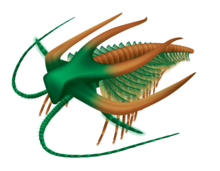
Back ماريلومورف Arabic ماريلومورف ARZ Marrellomorpha French Marrellomorpha Dutch Marrellomorpha Polish Marrellomorpha Portuguese Marrellomorpha Russian 马尔拉虫纲 Chinese
| Marrellomorpha | |
|---|---|

| |
| Life restoration of Marrella from the Burgess Shale | |
| Scientific classification | |
| Domain: | Eukaryota |
| Kingdom: | Animalia |
| Phylum: | Arthropoda |
| Class: | †Marrellomorpha Beurlen, 1930 |
| Subgroups | |
| |
Marrellomorpha are an extinct group of arthropods known from the Cambrian to the Early Devonian.[1] They lacked mineralised hard parts, so are only known from areas of exceptional preservation, limiting their fossil distribution. The best known member is Marrella, with thousands of specimens found in the Cambrian aged Burgess Shale of Canada. The group is divided up into two major orders, Marrellida and Acercostraca. Marrellida is recognised by the possession of head shields with two or three pairs of elongate spine-like projections, and three pairs of uniramous appendages on the cephalon, while Acercostraca generally have large ovoid carapaces that cover the entire upper half of the body, and five pairs of uniramous cephalic appendages. Both groups have unbranched antennules and a segmented trunk with biramous appendages.[2] Recent research has suggested the previously enigmatic Cambrian trilobite-like arthropods Skania and Primicaris belong to this group.[3][2] Their phylogenetic position is uncertain, various studies have alternatively placed them in the Arachnomorpha as relatives of Artiopoda (trilobites and kin), as related to Mandibulata, or as stem group euarthropods.[2] Some authors have proposed that they may be closely related to sea spiders (Pycnogonida) within Chelicerata though the cladistical support for such a relationship is relatively weak.[2]
- ^ Cite error: The named reference
appwas invoked but never defined (see the help page). - ^ a b c d Cite error: The named reference
:0was invoked but never defined (see the help page). - ^ Legg, D.A. (2015-09-30). "The morphology and affinities of Skania fragilis (Arthropoda) from the middle Cambrian Burgess Shale". Bulletin of Geosciences: 509–518. doi:10.3140/bull.geosci.1532. ISSN 1802-8225.